Beaten up with batons and electric shocks: "What is the difference with the Talibans?"
| 13.09.2022 | Near Horgoš border | No Name Kitchen | 46.1800276, 19.9674179 | Hungary | Serbia | no | no | yes | yes | no | no | no | 17 - 40 | 11 | Afghanistan | photos taken | 10 | beating (with batons/hands/other), kicking, pushing people to the ground, insulting, pepper spray, electric shock, pouring water over one's head, theft of personal belongings, stealing money | 10 Hungarian police officers, 3 police cars |
The two respondents were part of a group of 11 people who attempted to cross the border together, leaving from an informal settlement near Horgoš border to Hungary. All the people on the move were of Afghan origins, aged between 17 and 40 years old. The testimony was collected from the main respondent, a 40-year-old man, and a second respondent, an 18-year-old young man.
The first man recalls that the group made of 11 people left from the settlement in the early morning, around 5 AM, and around 10 AM they crossed the Hungarian border. Reportedly, only 5 minutes after having crossed, 3 police cars arrived with 10 "commandos" dressed up in military clothes and wearing balaklavas.
[caption id="attachment_21085" align="alignright" width="300"]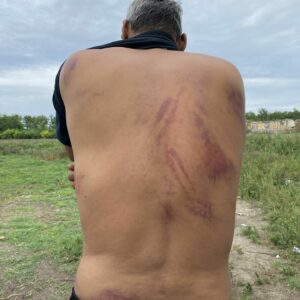 1st respondent's back after police violence.[/caption]
The "commandos" diffused pepper spray and ordered the group to lie on their stomach on the floor, face down.
The main informant reported that: "I couldn’t see what happened because I was face to earth" but he saw that the group was body-searched and he was told 2 smartphones were taken away.
[caption id="attachment_21084" align="aligncenter" width="450"]
1st respondent's back after police violence.[/caption]
The "commandos" diffused pepper spray and ordered the group to lie on their stomach on the floor, face down.
The main informant reported that: "I couldn’t see what happened because I was face to earth" but he saw that the group was body-searched and he was told 2 smartphones were taken away.
[caption id="attachment_21084" align="aligncenter" width="450"] 1st respondent's back after police violence.[/caption]
[caption id="attachment_21082" align="alignleft" width="100"]
1st respondent's back after police violence.[/caption]
[caption id="attachment_21082" align="alignleft" width="100"]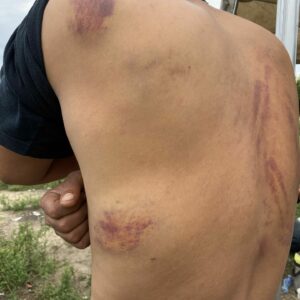 1st respondent's back and left side after police violence.[/caption]
[caption id="attachment_21083" align="alignright" width="300"]
1st respondent's back and left side after police violence.[/caption]
[caption id="attachment_21083" align="alignright" width="300"]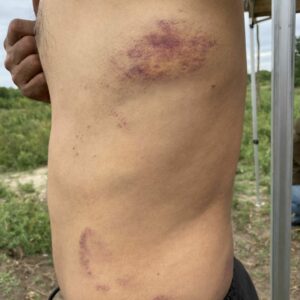 1st respondent's ribs after police violence.[/caption]
The officers took the backpacks of the people-on-the-move, and opened the energy drinks and Coca-Cola cans to pour them on the group's heads. Then, a few officers kicked the ground with their boots to spread soil on people's heads, so that the dirt stuck to their heads and clothes. The second informant explained that:
1st respondent's ribs after police violence.[/caption]
The officers took the backpacks of the people-on-the-move, and opened the energy drinks and Coca-Cola cans to pour them on the group's heads. Then, a few officers kicked the ground with their boots to spread soil on people's heads, so that the dirt stuck to their heads and clothes. The second informant explained that:
"They also took rocks and threw them on us"The main respondent recounts that he was beaten with a baton on his back, in the ribs on both sides, on his arm and shoulder on one side, and on his hand and foot. He also described that he received an electric shock on the lower back. He recalls others got electric shocks underneath their feet and that he was hearing insults such as "Fuck you" and laughter from the perpetrators. [caption id="attachment_21077" align="alignleft" width="300"]
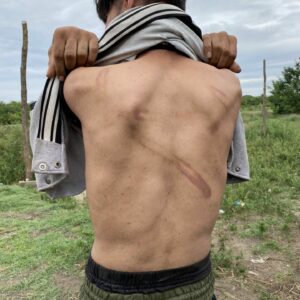 2nd respondent's back after police violence.[/caption]
The respondent believed he got the worst treatment because the "commandos" thought he was the leader of the group, even if he was not. The second respondent, one of the youngest of the group, also got beaten up on the back with a baton. Three days after this happened the main respondent still had issues walking and moving, in particular, he was feeling some pain in the ribs. The other one concluded, referring to the police officers that tortured them:
2nd respondent's back after police violence.[/caption]
The respondent believed he got the worst treatment because the "commandos" thought he was the leader of the group, even if he was not. The second respondent, one of the youngest of the group, also got beaten up on the back with a baton. Three days after this happened the main respondent still had issues walking and moving, in particular, he was feeling some pain in the ribs. The other one concluded, referring to the police officers that tortured them:
"What is the difference with the Talibans?"[caption id="attachment_21078" align="alignleft" width="300"]
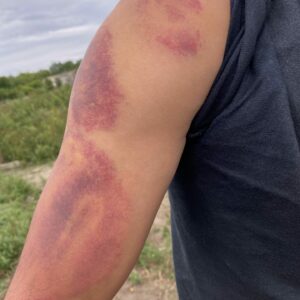 1st respondent's arm after police violence.[/caption]
The main respondent recalled that before the group had to enter a bus to leave, the officers had made a hill with their bags on the floor and counted up to 10, and if the people would not get their belongings before they finished counting, they would be kicked and not receive their bag back.
[caption id="attachment_21079" align="alignnone" width="600"]
1st respondent's arm after police violence.[/caption]
The main respondent recalled that before the group had to enter a bus to leave, the officers had made a hill with their bags on the floor and counted up to 10, and if the people would not get their belongings before they finished counting, they would be kicked and not receive their bag back.
[caption id="attachment_21079" align="alignnone" width="600"] 1st respondent's lower abdomen after police violence.[/caption]
The bus was then driven to Horgoš border. In the section before being released which was similar to a "box", the group was filmed with a camera, a video was taken from the front and from the back.
1st respondent's lower abdomen after police violence.[/caption]
The bus was then driven to Horgoš border. In the section before being released which was similar to a "box", the group was filmed with a camera, a video was taken from the front and from the back. 